AMERICAN NAVY CAMP AT CAMP HILL BRISBANE
JUNE 1943-FEBRUARY 1945.
This very large US Navy Hospital was part of the American World War Two
war effort against the Japanese in the Pacific. It was built on vacant land
behind the Camp Hill Hotel and up to 3000 staff and patients occupied the
area now containing Arrol, Errey, Ascham, Morven, Aubrey and Arrowsmith Streets
in the Brisbane suburb of Camp Hill. Camp Hill was named earlier in the
century and the name is not related to the US camp.
The area occupied was to the north of Old Cleveland Road
and running to Stanley Rd and from Kennington Rd in the east to the western
side of Arrol St, excluding the old timber Camp Hill hotel.
The camp consisted of a hospital, originally known as Navy
Mobile Hospital No 9. It was constructed in June 1943 by the 84th and 55th
US Navy Construction Battalions (CB's -Seabees). All US Navy Mobile Hospitals
were renamed in June 1944 with number designations being changed to start
with one hundred and one - thus Mob 9 at Camp Hill became Fleet Hospital
109. Some other U.S. Navy Mobile Hospitals were Mobile No. 4 (Fleet Hospital
104) and MOB 6 (FH 106) both in New Zealand; MOB 2 (FH 102) in Pearl Harbour;
MOB 5 (FH105) and MOB 7 (FH 107) both in New Caledonia; MOB 8 (FH 108) in
Guadalcanal; MOB 10 (FH110) and MOB 12 (FH 112) both in the Russell Islands;
FH 103, FH 111 and FH 115 in Guam; FH 114 in the Philippines. Because they
were mobile hospitals they could also have been located in other areas, for
example FH 105 is also recorded in New Zealand, and FH 103 in Tutuila, American
Samoa from May 1942 to April 1944, some probably moving to forward areas
as the front changed.
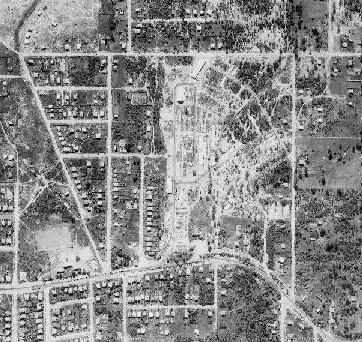 The aerial photo at the left, early 1946, shows the hospital
camp area (lighter shading - no vegetation). Some buildings remained on site
and these are visible along with the footings of the others. North is at
the top. Stanley Rd runs to the back (North), with Kennington Rd to the right.
Old Cleveland Rd runs from left to bottom right, with a thin dark strip
of bitumen, Ferguson Rd and Clara St forming the "V" about a third of the
way across. Camp Hill State School is to the left of this, the school oval
most discernible. The School of Arts (corner of Wiles St) is on the left
of the School block. In the larger photo version, which can be opened in
a separate window, the streets of the US Camp can be made out to be darker
(sealed) than the surrounding suburban Camp Hill Streets. In fact the layout
of the camp is quite clearly visible.
The aerial photo at the left, early 1946, shows the hospital
camp area (lighter shading - no vegetation). Some buildings remained on site
and these are visible along with the footings of the others. North is at
the top. Stanley Rd runs to the back (North), with Kennington Rd to the right.
Old Cleveland Rd runs from left to bottom right, with a thin dark strip
of bitumen, Ferguson Rd and Clara St forming the "V" about a third of the
way across. Camp Hill State School is to the left of this, the school oval
most discernible. The School of Arts (corner of Wiles St) is on the left
of the School block. In the larger photo version, which can be opened in
a separate window, the streets of the US Camp can be made out to be darker
(sealed) than the surrounding suburban Camp Hill Streets. In fact the layout
of the camp is quite clearly visible.
Click here to open
larger version of photo in a separate window. Close separate
window when finished to return to this point.
The land was requisitioned for the the US Navy on 21st May
1943. The site "was chosen for its high elevation by the medical officers
in charge". It was "constructed not only to care for US Navy personnel in
Australia but also to care for the sick and wounded brought to Australia
from the forward areas". The requisition to acquire the land can be opened
in a separate window. Close the separate window to return to this point.
Note "Date by which required - immediate", "Anticipated length of possession
- indefinite". Click here to open requisition.
Mobile 9 arrived in Brisbane with sufficient prefabricated metal buildings
to set up 500 beds, later expanded to 1000 then later to 2600. All buildings
were of prefab metal except a storehouse, theatre/recreation building, laundry,
sewage pump house and power plant. Construction was performed by Seabees
with assistance of station personnel. Construction was mainly of the task
force type which was not suitable for the tropical climate and made the interiors
very warm. It was well administered and had 2 large x-ray machines. The
operating theatres were air conditioned. It is reported that a major problem
was the installation of sewer and water lines.
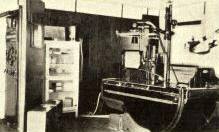
X-ray machine Mob 9, 1944
The types and number of huts, with dimensions in feet (approx metres)
were-
Task Force Type: 1 - 20x210 (7x70); 2 - 40x120 (13x40); 12 -
20x110 (7x36); 2 - 20x130 (7x43) ;
65 - 20x100 (7x33); 1 - 40x90 (13x30); 3 - 40x80 (13x26); 1 - 40x70 (13x23);
1 - 40x50 (13x16);
1 - 20x90 (7x30); 7 - 20x80 (7x26); 3 - 20x60 (7x20); 48 - 20x50 (7x16);
2 - 20x40 (7x13);
7 - 20x30 (7x10); 4 - 20x25 (7x8); 2 - 20x20 (7x7).
Lindsay Type : 2 - 20x30 (7x10).
Concrete: 1 - 20x20 (7x7) - Alcohol Store.
Frame Type: 1 - 60x130 (20x43) - Theatre/Recreation; 1 - 40x200
(13x66) - Warehouse; 1 - 40x130 (13x43) - Library/Gym; 1 - 40x80 (13x26);
2 - 20x120 (7x40); 3 - 20x50 (7x16); 1 - 20x20 (7x7); 1 - 20x25 (7x8);
1 - 15x30 (5x10);
2 - 10x15 (3x5).
The above list, late 1944, totals 179.
Click here to open
a WW2 era plan in a separate window showing where various activities were
located, expand plan inside browser. Close separate window when finished to return to
this point.
The theatre/recreation building hosted overseas entertainers
to lift the spirits of the patients and staff. Reputedly among these were
actor Clarke Gable and Joe di Maggio. The hospital also sponsored an International
Navy Championship Rodeo in October, 1944. This was a contest between Australian
and US rodeo champions. A novelty event in this rodeo was JEEP JUMPING JEEP
performed by Lt. Dick Ryan, U.S.A. rodeo producer and former stunt man in
which he jumped a jeep over a stationary jeep.
Staff comprised 22 medical officers, 48 nurses, 2 chaplains,
3 supply officers, 1 electrician, 1 machinist, 396 corpsmen (medics), 317
non-medical ratings plus various small numbers of other occupations. Captain
H.A. Bruckshaw is listed in a military phone book as being the commanding
officer of Mobile Hospital No. 9 in 1944. The maximum patient census was
2200 and averaged 1500 to 1900 patients at one period. Admissions for the
first 10½ months of 1944 were 8411, comprising 511 battle casualties, 1024
non-battle casualties and diseases including malaria, dysentery and scrub
typhus. During this same period 3961 patients were discharged to duty and
4737 returned to the US.
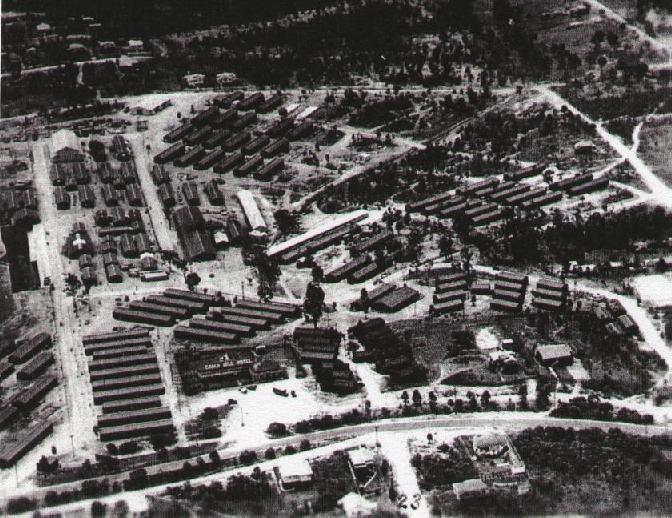
This photo, probably taken in 1943/early 1944, shows the
array of buildings, including the theatre/recreation building at the end
of Arrol Street, before Ascham Street on the right hand side. The library/gym
on the left side of Arrol Street not yet constructed (see "Crew's Recreation
Hall O.K.'d on page 5 of the August 15 magazine below). (Note sign Camp
Hill Hotel)
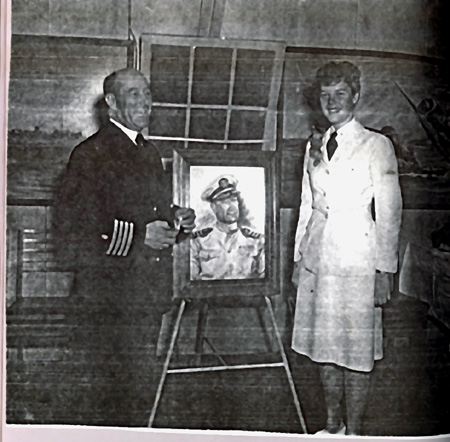
Sketch of Capt Bruckshaw, CO, presented
to him by the artist, Nurse Ensign Virginia Harvey, at Camp Hill, at the
celebration of the hospital's first anniversary June 1944.
(Photo courtesy Ken - ex US Submarine
Gar - and Virginia Holcolmbe, USA, Aug 2008)
Forty percent of the buildings were shipped out in 1945.
The 109th Fleet Hospital was transferred to the Philippines by the US Navy
cargo ship "Venus" on 4th February 1945 along with Construction Battalion
Maintenance Unit (CBMU) 544 (source Navy Ships www.hazegray.org./danfs/auxil/ak.135.txt
) .
The question of the current street layout is answered by
the sealed roads in the 1946 aerial photo. The positioning of Arrol St is
the same as now with a short extension to Stanley Rd and a now straight
rather than curved entry to Old Cleveland Rd. The eastern (right hand) side
of the Arrol St "loop" in the photo now exists for only ten metres or so
at the top of Aubrey St, but the flat area of the remainder can still be
seen at the top of the park behind the houses now fronting Arrol Street.
Errey, Morven, Ascham, Aubrey and Arrowsmith appear to be in exactly the
same position as now.
After the war the area reverted to the Australian Army
Hiring Services. Despite several of the holders of the original 23 land titles
trying to get their requisitioned land back, eventually it was all resumed.
The land was acquired by the War Service Homes Commission around 1947, although
it appears that sale of the sub-divided blocks did not occur until a couple
of years later.
The sub-division of the area required a layout plan designed around
the U.S. constructed roads. The surveyor responsible later had to justify
his additional charges caused by fitting in the residential blocks around
the unusual street layout.
The amount of time that elapsed between the end of the war and
the time houses were built meant that the unsold blocks had to be re-valued
when the “Belmont” tram was extended to Carina in 1948.
A number of non pre-fabricated buildings remained on the site into
1947, including the Picture Theatre, Gym and Library, Sewage Pump building
and Warehouse. Typical construction of these buildings was concrete floor,
corrugated asbestos cement roof, fibrous asbestos cement walls and caneite
interior. Even after demolition of the Warehouse the concrete floor slab
remained for some time. Measuring 40 feet by 200 feet and at an angle of about
45 degrees to both Stanley Road and Arrol Street it was ideal for riding Dinky
tricycles.
The caneite interior of the Picture Theatre
was at particular risk post war, as it was used by the Potato Board for storage,
and when they moved out there was a report of numerous holes in the lining,
apparently caused by potatoes being thrown at it.
There were also 3 thirty feet tall air-conditioning cooling
towers left on the site.
In May 1946, Mr McQuay, the licensee of the Camp Hill Hotel,
who leased it from Castlemaine Perkins Ltd, wrote to the Department of the
Interior seeking to buy the Gym and Library building, the remains of the
Officers’ Mess and the remains of the Laundry. These buildings were on 6 acres
of Hotel land that was part of the Hospital area. He was unsuccessful.
Among the names eventually given to the U.S. constructed
streets were Morven, Errey and Orwell, names that had been proposed in the
1930’s for a rectangular sub-division at the corner of Kennington Rd and
Stanley Rd, in the area that Arrowsmith St now curves through.
Lavarack Park, in the centre of the Hospital site has developed
over the years into a valuable community asset, and perhaps fittingly in
June 2003, on the 60th anniversary of construction of Mobile No 9, the park
is currently the subject of further improvement, which is expected to recognise
in some way the occupation of the site by so many people during the war.
Click here to see the September 1944 issue of the hospital
magazine, in a separate window. Close separate window to return to this
point.
Click here to see the August 1944 issue of the hospital magazine,
in a separate window (includes mention on p.7 of baseball players Phil Rizzuto,
Don Padgett, Charlie Wagner, Dom Di Maggio and Benny McCoy). Close separate
window to return to this point.
Click here to see the April 1944 issue.
Click here to see WW2 era photos of the picture theatre / recreation
building, camp band, gym, people and a comparison of current streets with
the camp layout. Close separate window to return to this point.
Click here to see camp area as it is today, in a separate
window. Close separate window to return to this point.
OTHER LINKS
Click on "OTHER LINKS" to go to links on:
The US Navy.
Navy Medical Art by Carlos Andreson from the Abbot Collection
Finding out more about Brisbane today .To locate the present
site of the camp use the "Whereis Street Directory" and type in Aubrey Street
Camp Hill Qld as the street search.
Why this site
Any further information about the hospital is welcomed.
Email to
David Morgan
moresby5@hotmail.com
Acknowledgements
Assistance from
André Sobocinski (US Navy Bureau of Medicine Navy History)
The Brisbane City Council Archives
Peter Dunn ( ww2 webpages)
Judy Rechner (Historical Researcher)
is gratefully acknowledged.
References:
1.Inspection Report of Fleet Hospital 109,
December 1944 (U.S. Navy)
2.History of Naval Hospital Binder (U.S. Navy Bureau
of Medicine and Surgery).
3.Building the Navy's Bases in World War II: History of
the Bureau of Yards and Docks and Civil Engineers Corps, 1940-1946 Vols.
1 & 2 (U.S. Government Printing Office 1947)
4. Various files – National Archives of Australia, Brisbane.
5. Various files – U.S. National Archives.
This page first written 8 Nov 2001
Updated 29 May 2002 (building details & plan)
Updated June 2003 (info on postwar use)
Updated July 2006 (addition of Sept 1944 Magazine)
Updated Sept 2007 (addition of August 1944 Magazine)
Updated July 2020
Optus website moved to Neocities March 2024
DISCLAIMER
It is intended to update this site as more information comes
to hand.
While every care has been taken in compiling this information
some of it may be incorrect or incomplete. The authors of this website, any
source mentioned or any reference quoted should not be held liable for any
factual errors. Any person intending to use or rely on this information
should first confirm it for themselves from other sources.
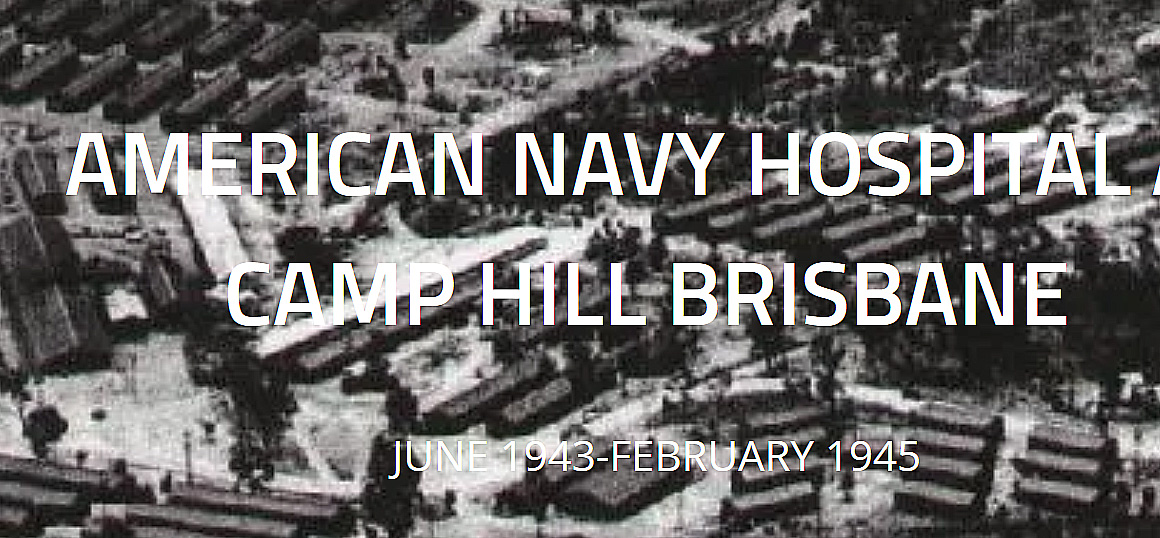

 The aerial photo at the left, early 1946, shows the hospital
camp area (lighter shading - no vegetation). Some buildings remained on site
and these are visible along with the footings of the others. North is at
the top. Stanley Rd runs to the back (North), with Kennington Rd to the right.
Old Cleveland Rd runs from left to bottom right, with a thin dark strip
of bitumen, Ferguson Rd and Clara St forming the "V" about a third of the
way across. Camp Hill State School is to the left of this, the school oval
most discernible. The School of Arts (corner of Wiles St) is on the left
of the School block. In the larger photo version, which can be opened in
a separate window, the streets of the US Camp can be made out to be darker
(sealed) than the surrounding suburban Camp Hill Streets. In fact the layout
of the camp is quite clearly visible.
The aerial photo at the left, early 1946, shows the hospital
camp area (lighter shading - no vegetation). Some buildings remained on site
and these are visible along with the footings of the others. North is at
the top. Stanley Rd runs to the back (North), with Kennington Rd to the right.
Old Cleveland Rd runs from left to bottom right, with a thin dark strip
of bitumen, Ferguson Rd and Clara St forming the "V" about a third of the
way across. Camp Hill State School is to the left of this, the school oval
most discernible. The School of Arts (corner of Wiles St) is on the left
of the School block. In the larger photo version, which can be opened in
a separate window, the streets of the US Camp can be made out to be darker
(sealed) than the surrounding suburban Camp Hill Streets. In fact the layout
of the camp is quite clearly visible. 

